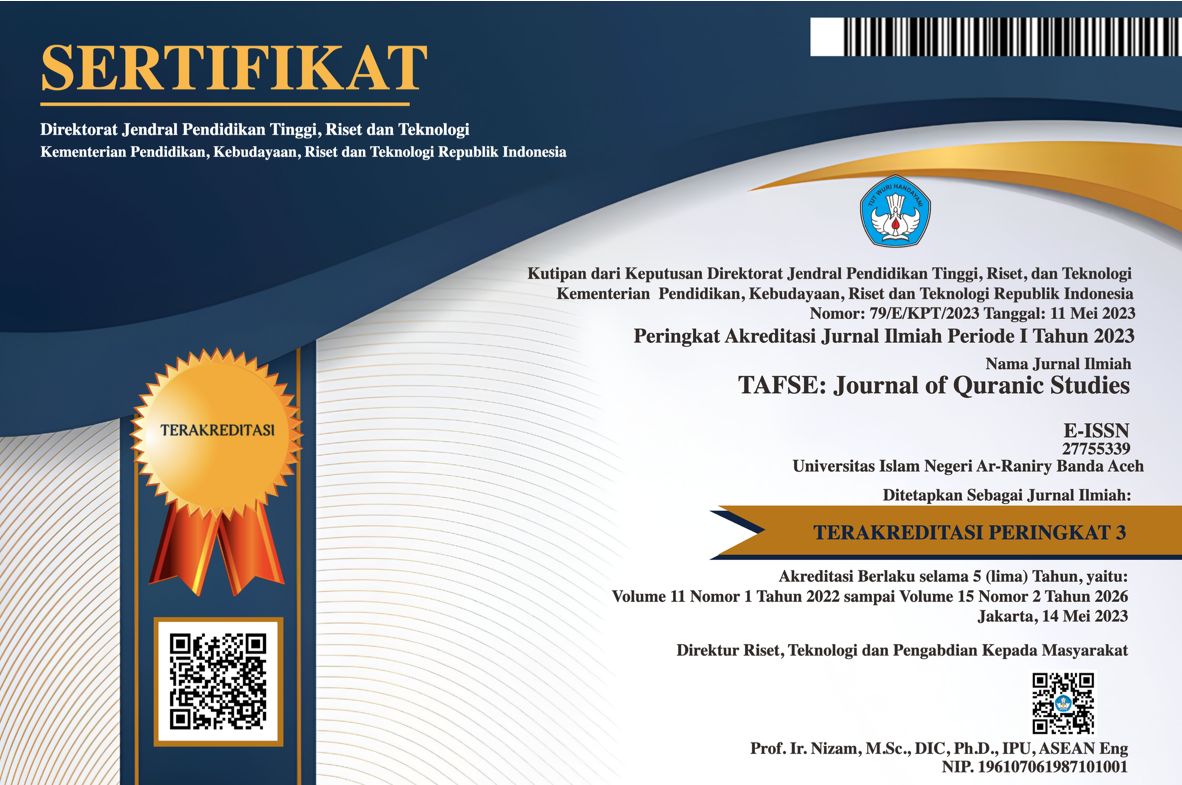Penyetaraan Wanita dengan Anjing di Depan Orang Salat: Sebuah Kajian Fiqh al-Hadis
DOI:
https://doi.org/10.22373/tafse.v2i2.13601Keywords:
Wanita, Anjing, Batalnya SalatAbstract
A proper understanding of the traditions regarding the interruption of prayer due to the passage of a dog and a woman is a significant study, considering that this hadith seems insulting to women because the position of women is mentioned in this hadith lying down with dogs or equating human species with animal types. For this reason, this study will focus on looking at the meaning of the hadith when prayer is interrupted due to the crossing of a dog and a woman, what are the implications of these traditions for the validity of prayer, and what are the criteria for dogs and women in the hadith. The author uses a linguistic and socio-historical approach, using the science of fiqh al-Hadith as the main analytical tool. The results showed that from a linguistic and socio-historical point of view, the meaning of dog and woman is understood textually to mean that causing the prayer to be interrupted is to destroy the prayer or cancel the prayer, while contextual understanding means that it is a symbol that can reduce the busyness of prayer. The implication of fiqh al-Hadith is textual means to break the prayer or cancel the prayer, while contextually it means reducing the solemnity of prayer or the value of the quality of prayer, not canceling the prayer. The criteria for the dog in the hadith are a black dog which is linguistically a symbol of Satan and a woman who has reached puberty as a temptress for those who look at her.
Pemahaman yang tepat terhadap hadis-hadis tentang terputusnya salat karena melintasnya anjing dan wanita merupakan suatu kajian yang signifikan, mengingat hadis ini terkesan menghina kaum wanita, karena posisi wanita disebut di dalam hadis ini berbaringan dengan anjing atau penyamaan jenis manusia dengan jenis binatang. Tulisan ini akan fokus melihat bagaimana maksud hadis terputusnya salat karena dilintasi anjing dan wanita, bagaimana implikasi hadis-hadis tersebut terhadap sahnya ibadah salat, dan bagaimana kriteria anjing dan wanita dalam hadis tersebut. Penulis menggunakan pendekatan linguistik dan sosio-historis, dengan menggunakan ilmu fiqh al-Hadis sebagai alat analisis utama. Hasil penelitian menunjukkan bahwa ditinjau dari sisi kebahasaan dan sosio-historis, pemaknaan anjing dan wanita jikan dipahami secara tekstual berarti menyebabkan terputusnya salat adalah merusak salat atau membatalkan salat, sedangkan secara kontekstual berarti sebagai simbol yang dapat mengurangi kekusyukan salat. Implikasi fiqh al-Hadis secara tekstual berarti membatalkan salat, sementara secara kontekstual berarti mengurangi kekusyukan salat atau nilai kualitas salat bukan membatalkan salat. Kriteria anjing dalam hadis tersebut adalah anjing hitam yang secara linguistik sebagai simbol dari setan dan wanita yang sudah baligh sebagai penggoda bagi orang yang memandang kepadanya.
Downloads
References
A. J. Wensinck. al-Mu'jam al-Mufahras li Alfaz al-Hadis. Leiden: E.J.Brill, 1943.
A. J. Wensinck. Miftah Kunuz al-Sunnah, Terj. Muhammad Fu'ad Abdul Baqi. Kairo: t.p., 1924.
Abdullah ibn Muslim ibn Qutaibah al-Dainuri. Ta’wil Mukhtalif al-Hadis. Beirut: Dar al-Fikr, 1995.
Abu Abbas Syihab al-Din Ahmad ibn Muhammad ibn al-Qastalani. Irsyad al-Sari li Syarh Shahih al-Bukhari. Beirut: Dar al-Fikr, t.th.
Abu Abdillah Muhammad bin Isma’īl ibn Ibrahim ibn al-Mughirah. Shahih al-Bukhari, Juz 1. Beirut: Dar al-Fikr, 1981.
Abu Abdillah Muhammad ibn Yazid al-Qazwini. Sunan ibn Majah, Juz 1. Beirut: Dar al-Fikr, t.th.
Abu Fadl Jamal al-Din Muhammad ibn Makram. Lisan al-‘Arab, Jilid 8. Beirut: Dar Sadir, t.th.
Abu Tayyib Muhammad Syamsul al-Haq. ‘Aun al-Ma’bud, Juz 2. Madinah: Maktabah Salafiyah, 1968.
Ahmad Ibn Ali Ibn Hajar Al-Asqalani. Fath al-Bari bi Syarah Shahih al-Bukhari. t.tp. :Maktabah salafiyah,t.th.
Ahmad Warson Munawwir. Kamus al-Munawwir Arab-Indonesia Terlengkap. Surabaya: Pustaka Progressif, 1997.
Al-Nawawi. Shahih Muslim bi Syarh al-Nawawi, Juz 4. Beirut: Dar al-Fikr, 1981.
Jalaluddin al-Suyuti. Sunan al-Nasai bi Syarh Jalaluddin al-Suyuti Wa Hasiyah al-Imam al-Sanadi, Juz 2. Beirut: Dar al-Fikr, 1930.
M. Syuhudi Isma’il. Cara Praktis Mencari Hadis Nabi. Jakarta: Bulan Bintang, 1991.
Muhammad al-Ghazali. Studi Kritis atas Hadis Nabi saw. antara Pemahaman Tekstual dan Kontekstual. Bandung: Mizan, 1993.
Downloads
Published
Issue
Section
License
Authors who publish with this journal agree to the following terms:
- Authors retain copyright and grant the journal right of first publication with the work simultaneously licensed under a Creative Commons Attribution License (CC BY NC 4.0) that allows others to share the work with an acknowledgment of the work's authorship and initial publication in this journal.
- Authors are able to enter into separate, additional contractual arrangements for the non-exclusive distribution of the journal's published version of the work (e.g., post it to an institutional repository or publish it in a book), with an acknowledgment of its initial publication in this journal.
- Authors are permitted and encouraged to post their work online (e.g., in institutional repositories or on their website) prior to and during the submission process, as it can lead to productive exchanges, as well as earlier and greater citation of published work (See The Effect of Open Access).





